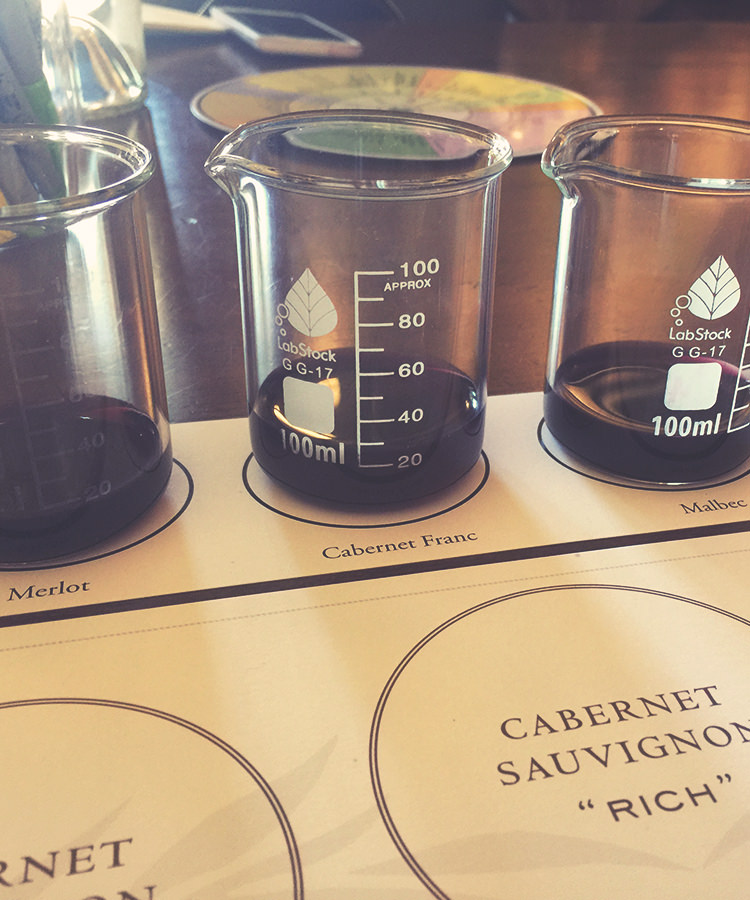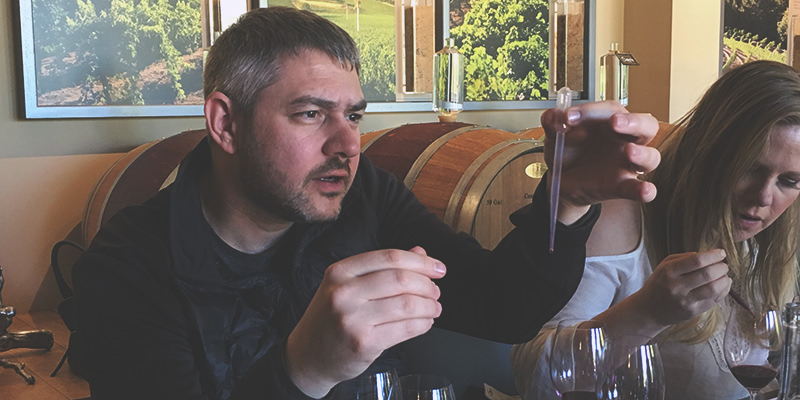I have always been fascinated by the art of the blend. Recently, I got to try if for myself, at Conn Creek in Napa. It was an invaluable experience that taught me about wine from an angle I never thought I’d see first-hand. It is one thing to study blending from afar and talk about the science of it; it is quite another to be doing it hands on.
It was like arts and crafts for wine lovers. In front of me was a tasting mat with seven wine glasses arranged in an arc. Five of them were filled with Cabernet Sauvignon from single vineyards in five different AVAs in Napa, showcasing the diversity of terroir around the region. Under each glass was a circular place marker to fit the base of each glass. Each place marker had a word: soft, supple, complex, rich, and bold. The last two placements had empty wine glasses. Just above the blending arc of terroir, as I was calling it in my mind, were four beakers with their own markers, filled left to right with Merlot, Cabernet Franc, Malbec and Petit Verdot. In the center of the tasting mat were text boxes for each category to jot down tasting notes. I can’t explain in words how excited I was to begin. Oh, and there was the spit cup… yeah, whatever.
The first step was to taste each of the Cabs and assess the nose and palate, paying attention to acidity and tannin structure as well as aromas, taking notes on each one to assemble the base Cabernet blend. We would then create two mock blends that we liked and move to the remaining varieties to decide whether we wanted to incorporate any of them for a meritage-style wine or stick with Cab only.
I sniffed and sipped each one, trying to focus through my fervor. As I tasted through the different AVAs, the possibilities seemed endless. How was I going to make my initial blend? I decided to be a wine Jedi and just go with the flow, taking it one step at a time and focusing on each wine without thinking about the one previous and whether I would want it in my blend. With the California sun beaming through the windows and the rolling hills of Napa on the horizon, the Force was strong within me and I blissed out. I was in my own personal montage, cuing up some dub step CSI music in my head, talking to myself, scribbling tasting notes, comparing the five vineyards in front of me.
Explaining my thought process at that time is like describing a feverish dream, but let me break down how all this went through my gray matter. The wine labeled “complex” had nice tannin and soft, concentrated fruit, with good aromas of currant and cherry retaining some of that inherent pepperiness Cab can have. The “supple” was a bit more linear with more of a tannin structure and more of a blackberry note. But both the complex and the supple had good medium acidity, so I knew I would use one of those. The “soft” was earthy and juicy with a calm, bright red berry fruit. It had a nice bracing acidity and low tannin. It was very fruit-driven and I could see this blending well with either the “complex” or the “supple.” Still with me? The wine labeled “rich” had significant and concentrated tannins along with low acid, giving it a more extracted character. Those peppery notes were there to give the wine a nice backbone and I knew immediately that this one had to be in the blend. It had similar fruit characteristics to “soft” and “supple” but that backbone had me all excited. “Bold” was probably my favorite of the five, with savory aromatics and hints of licorice and a slight waft of cola. The tannins in this one were right where I like them, recognizable but well integrated into the body of the wine. I knew that this one was going to have a starring role in my blend.
I now had to put my notes into action and make two mock blends using the pipette. I was nervous. This was it. This was the base blend. Could I do this? Was I prepared for failure? That’s when the wine geek in me piped in like a Force Ghost and said, in the words of master Yoda, “Do or do not, there is no try.” So I did.
I knew I wanted a lot of the bold in my blend but wanted to scale it back a bit for the first mock-up, just to see how it would compare, so I went one supple, two rich, and two bold. I swirled. I sipped. I made a base blend! It was amazing to smell and feel the tasting notes come alive on my palate. The acidity was pretty much where I wanted it. I’m an acid head and love higher-acid wines that really amplify aromas. There was a medium tannin level. which I thought gave the wine a nice backbone. This was kind of working out. But I really loved that “bold,” so on mock-up No. 2 I cut back on the “rich,” kept the “supple” at two, and increased the “bold” to three. Wow! That was it. I found it. Yoda would be proud. Just the right amount of tannin and a nice round aromatic fruit with hints of red berry and a slight savory pepper and licorice nose.
But I wasn’t done. There were the other four varieties to think about to make up the full blend. We could use two pipettes full of any of the Merlot, Cab Franc, Malbec, or Petit Verdot. If I stuck with just the Cab I would have to add more quantity to what I had and I was too content to mess around with that. I didn’t want to encroach on the aromas by adding lean peppery notes with the Cab Franc, and the Malbec and Petit Verdot would be too powerful and overwhelm the subtlety I had somehow achieved. But Petit Verdot can really give a wine a little more color and slight added structure. Merlot seemed to be the best bet because Merlot is primarily about texture more so than aromas, and that texture is supple in itself.
For the first mock-up I put in one and a half pipettes of Merlot and a half-pipette of Petit Verdot. In my second mock-up I did two full Merlot pipettes. The Merlot did the trick. It didn’t mess too much with the style and structure of the blend and added a soft, plush cushion in the texture department. The Petite Verdot was a just a little too heavy and took away from the subtle aromas I was digging so highly.
I couldn’t believe it I had just barrel-blended my own little masterpiece. I went around the room and and filled larger beakers with 800 milliliters of wine from the barrels we had just sampled and blended from. I then funneled it into a wine bottle and corked it. VOILA! Back at my wine-stained place setting, the staff had given us blank Conn Creek wine labels and, in true primary school fashion, the crew I was with and I took to the colorful magic markers and named our wine: Chateau Castor Wine Skool’D Blend.
To experience first-hand how to balance acidity and texture in a wine and to be able to build your own structure is such a great way to understand wine. I am still not sure if I made the right decisions and will know in about a month when I open my bottle of Chateau Castor Wine Skool’D Blend if everything jibes. I have heard winemakers say that blending is their favorite part of winemaking, and I sure had a ton of fun, but this was just one wine. Imagine if this was the decision you had to make to represent your whole vintage as a representative of your brand. It’s like mixing an album. When are you satisfied?
I have definitely learned to respect the blend and the experienced palates that need to smell and taste for the smallest of elements to find that perfect harmony. This crash course was great and I got a sense of those subtleties. If you are ever in Napa and you love wine, check out Conn Creek’s blending class. It’s only $125, which is a steal for what you experience, and for an extra $55, you can get an additional bottle of your wine. You can even save your blend and order it by the case. This class will definitely give you a new respect for the art of winemaking.

